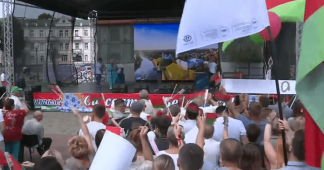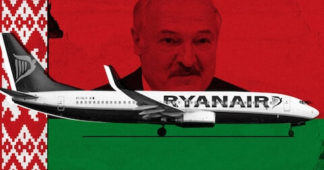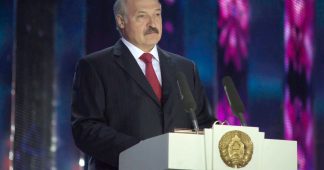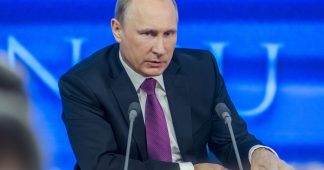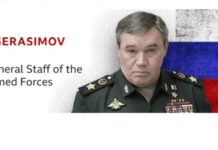By Alexei Sakhnin
29 July 2021
At the end of June, the European Union introduced a fourth set of sanctions against Belarus in response to the detention of opposition journalist Roman Protasevich, after his Ryanair flight was forced to land in Minsk the previous month. The new measures will affect key areas of the economy: potassium fertilizers, oil, tobacco, as well as access to EU capital markets. Washington has vowed to introduce similar restrictions. Yet for the time being it looks as if the Belarusian regime has faced down its adversaries, external and internal. The US and EU-backed opposition is in ruins. The mass protest movement that began in 2020 has practically vanished, although support for the government has also fallen significantly.
Alexander Lukashenko has ruled over Belarus’s 10 million people since 1994. For decades he championed the so-called ‘Belarusian Way’, which sharply differentiated the Republic from other post-socialist countries. For the first three years after the fall of the Soviet Union, the rapid marketization of the economy caused social collapse and mass discontent. Lukashenko presented himself as the solution to these ailments. He slowed the pace of privatization, partially reinstated price controls and restored elements of central planning. He established economic ties with Russia and brought back some of the social guarantees from the Soviet era. Manufacturing remained under government control, deindustrialization was halted.
Such policies set off a growth spurt. Since 1990, Belarus’s real GDP has doubled, manufacturing has tripled, and agricultural output has increased by 37%. In Russia, by comparison, real GDP has only grown by 20% over 30 years. GDP per capita in Belarus is lower than in the rest of Europe, but the gap is narrowing. The country has one of the lowest levels of social inequality in the continent, with the incomes of the top 10% only six times higher than the poorest 10%. These successes turned Lukashenko into one of the most popular politicians in the post-Soviet space, earning him the nickname ‘Bat’ka’ – the father. At the turn of the century, Russian politicians were wary of political integration with their neighboring republic, fearing that Minsk’s premier would become a powerful presence in the Kremlin.
Yet Lukashenko never attempted to convert his popularity into a mass movement or a coherent ideology. His regime has always been a centralized bureaucracy. Grassroots initiatives are distrusted and suppressed. The government and its propaganda apparatus have sought to demobilize even loyal supporters, assuring them that popular participation is unnecessary. Lukashenko may have restored some Soviet symbology – such as the flag and anthem of the Belarus Soviet Socialist Republic – but his leftism goes no further than that. The regime’s socio-economic reforms were merely enough to guarantee passive loyalty from the majority of the population and marginalize the liberal-nationalist opposition.
But the situation began to change after the onset of the world economic crisis. Despite its resistance to shock therapy, Belarus had steadily been integrating into global markets. Throughout the 90s and 2000s, Minsk was critically reliant on energy supplies from Russia, whose oligarchs were eager to gain approval for the privatization of Belarusian gas transportation and oil refining industries. These negotiations led to rising tensions with Moscow, which in turn pushed the republic toward dependence on Western imports (hence its current vulnerability to sanctions). During the 2010s, falling demand in the world market and protectionist measures adopted by Western governments finally sapped the dynamism of the Belarusian economy. To make its manufacturing output more competitive, the government devalued the national currency twice. Real incomes fell, and Lukashenko expanded the public sector to prevent mass unemployment. Soon there was not enough money left in the budget for social services. Austerity and incremental privatization followed; the pension age was increased and labour rights were eroded. In an attempt to restock the state coffers and eradicate the grey economy, the government introduced a highly unpopular ‘freeloader’ law which required all those who are not officially employed to pay the government a fixed fine.
Thus did Lukashenko’s ‘social state capitalism’ begin to falter. Even its previous victories came back to bite it. Having created one of the most successful IT-clusters in the world, employing over 100,000 people and attracting significant foreign investment, Belarus’s tech workers turned against the government after 2010. This section of the population was embedded in the global economy, favoured market-friendly reforms and saw the sluggish Belarusian ‘social state’ as a socialist hangover. They demanded regime change and a complete repudiation of this legacy. ‘We now have the bourgeois, rich people, IT people’, complained Lukashenko, ‘whom I created…providing them with conditions that would be impossible elsewhere. And now they want power.’
Faced with this movement, Lukashneko again did nothing to mobilize the support of the wider population. He knew that, as well as weakening the grip of the bureaucracy, the masses would oppose the creeping liberalization which he saw as the only way out of the economic crisis. Instead, Bat’ka took a nationalist, pro-Western turn, hoping to outflank the opposition on cultural issues and strengthen the regime’s legitimacy. He refused to accept the annexation of Crimea by Russia in 2014, stopped delivering his presidential speeches in Russian, and increased the hours dedicated to Belarusian language in schools. At a press-conference in 2014, Lukashenko declared that Smolensk, Bryansk and Pskov rightfully belonged to Belarus: an overture to far-right nationalists who see the country as an heir to the medieval Great Duchy of Lithuania. He proposed a tactical union with the opposition against Russian revanchism and entered further into NATO’s orbit. As recently as 2017, the president referred to himself as an ally of the EU.
But it was no good. Lukashenko could not win over the liberal-nationalist opposition, especially once the fear of Russian expansionism had subsided. Nor could he endear himself to Western powers, who would accept nothing short of full-scale privatization of Belarusian industry and a turn toward political liberalization that would allow them to influence the makeup of government. The anti-Lukashenko forces inside and outside the country continued to lambast ‘the last dictator in Europe’. For the previously loyal majority, the president’s nationalist turn was disorienting. His most popular policies – social provisions and friendship with Russia – had been abandoned. He had refused to assemble a coalition in favour of preserving the Belarusian Way. The pro-government camp predictably fell apart. Passive support mutated into apathy, or outright hostility.
As many as 1 million people – more than 10% of the population – participated in the anti-government protest movement of 2020. According to the Centre for East European and International Studies, a little less than half of Belarusians supported the protestors: 29% fully, 16% partially. Only a third opposed them (although if we include senior citizens and rural citizens, who were not accounted for in this survey, the figure rises to about 45%). But liberal-nationalist leaders squandered their popular support by failing to put forward a compelling economic programme. Eager to dismantle the remnants of socialism, they offered no vision for Belarus beyond unpopular market reforms. This gradually alienated workers and the unemployed, most of whom have now either split off from the protest movement, or made clear that their discontent with the government does not equate to support for the opposition. This loss of numbers, along with escalating repression, has checked the momentum of the protests. In the first four days of the upheaval, around 7,000 people were detained: a tally that increased to 33,000 a few months later. Between four and seven protestors died, six disappeared and over 200 were wounded. By the beginning of September, the UN had already documented over 450 instances of torture.
The story of Roman Protasevich’s arrest speaks to the character of the current opposition movement. Protasevich had been an opposition activist since 2010. He travelled to Ukraine in 2014, where he claimed he fought in Donbass as part of an ultra-right Azov battalion. (It was later said that he was not a militant but a journalist, although there is no evidence of Protasevich’s publications from that period). In 2017, Protasevich and Stepan Putilo created the telegram channel NEXTA, which soon became the main broadcaster of the Belarusian opposition, gaining over 2.5 million subscribers. Three years later, Protasevich abruptly stepped down as editor-in-chief. He did not explain his decision at the time, but has since suggested that ‘outside curators’ handled HR decisions, and that NEXTA was being funded by Western patrons.
In May 2021, Protasevich flew to Greece with his girlfriend to meet the exiled Belarusian opposition politician Svetlana Tikhanovskaya. He was hoping to become her official photographer, but she did not take him up on the offer. It seemed that his position at the top of the opposition’s thriving media industry had been lost, leaving him full of bitterness about his former comrades. There was speculation that his dismissal had been the result of maneuvering by factional opponents.
Protasevich struck a deal with the authorities shortly after his arrest and is now playing a major role in the state propaganda campaign. He has admitted to stoking ‘chaos’ in Minsk in August 2020 and claimed that the opposition is sponsored by ‘Lithuanian taxpayers’, Russian oligarchs and Western powers. He has lauded Lukashenko, describing him as ‘a man with balls of steel’ who refuses to cave under external pressure. Protasevich’s father argues that his son has been coerced into making such statements: an assumption reiterated by liberal journalists in Russia and Belarus, and taken for granted in the US and Western Europe. But Protasevich, who signed a plea bargain and is currently under house arrest, maintains that no one has made him say anything he didn’t want to say. His denials could be motivated by fear, but they could also be a sign of shifting loyalties. Shunned by the opposition, might Protasevich instead be seeking refuge with the regime?
If so, this personal drama is symptomatic of a broader process: by refusing to build an oppositional ideology rooted in the concerns of ordinary Belarusians, the anti-government movement is fast becoming a tech-savvy business project, whose main goal is to fight the state for control over resources. Often, its leaders are driven by entrepreneurial instincts rather than political convictions – which means they are liable to flip should the government offer them a better deal. There is no sense of solidarity or collective action among this cohort, whose purse strings appear to be controlled by foreign actors. Lukashenko’s propagandists like to say that ‘a dictatorship is better than puppet democracy’. It is to the discredit of Belarusian opposition that they help to legitimize this mantra.
Read on: Dmitri Furman, ‘Imitation Democracies’, NLR 54.
Published at newleftreview.org
